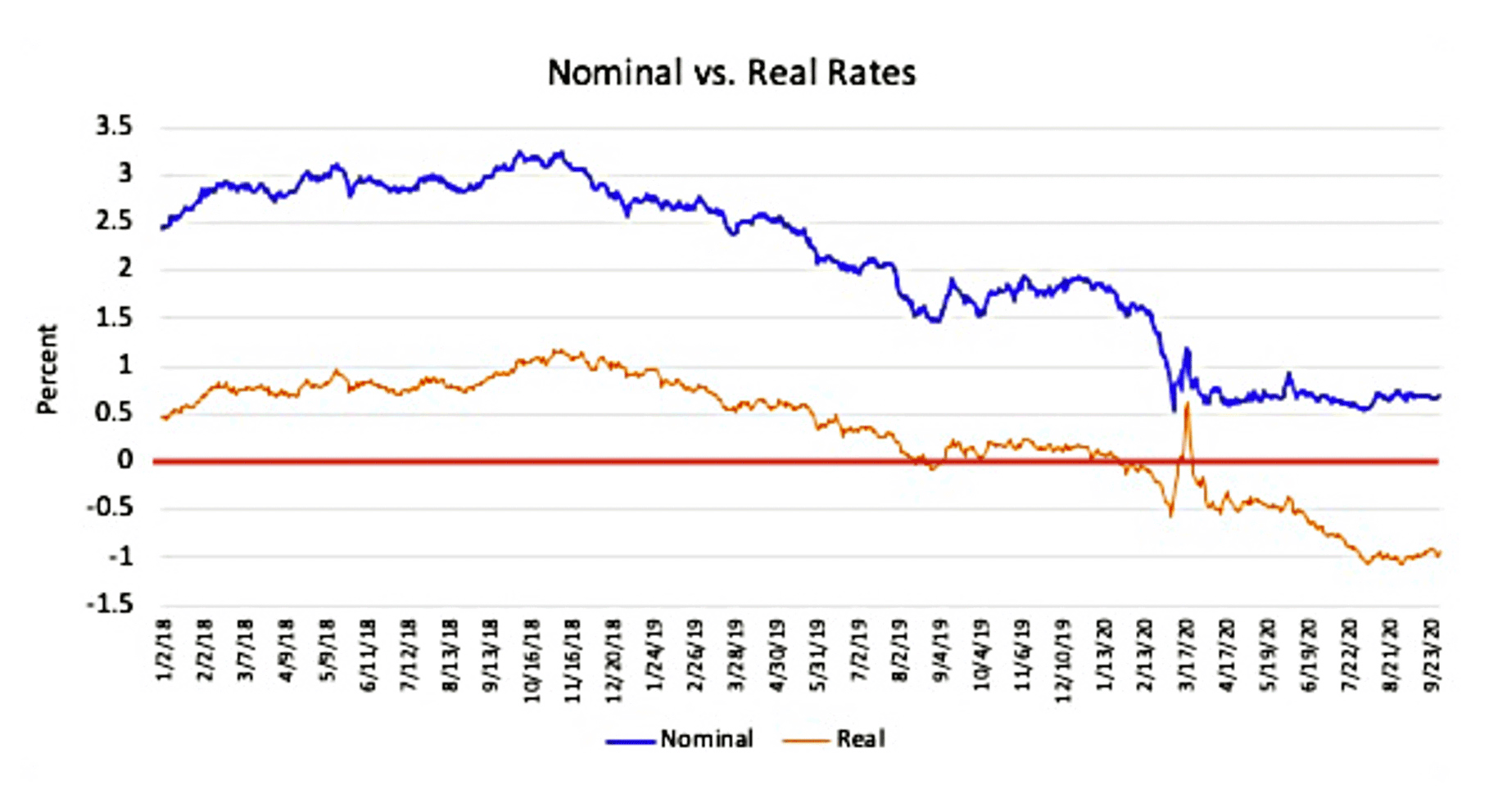Don’t Bank on the Safety of Bonds in a Pandemic
Bond yields are too low to follow the old investing playbook. Here are some tips to restructure the bond side of your portfolio today.


Today’s market environment requires that we talk candidly about bonds. While investors over the years have turned to bonds for safety, unfortunately they’ve never been riskier than they are right now.
Over long periods of time, bonds have generated lower returns and lower risk than equities. Bonds also had low correlation with equities, which generates diversification return. Generally, bonds are thought of as safe. Over the last 50 or so years, the 10-year U.S. government bond has produced average annual returns of around 7%.
Ah, the good old days. If you purchased a 10-year U.S. government bond on Oct. 1, 2020, the bond would have yielded 0.68%. In other words, over the next 10 years you would expect to get an average annual return of 0.68%. That’s about 90% less than the average returns over the past 50 years. It’s also pretty close to zero.
From just $107.88 $24.99 for Kiplinger Personal Finance
Become a smarter, better informed investor. Subscribe from just $107.88 $24.99, plus get up to 4 Special Issues

Sign up for Kiplinger’s Free Newsletters
Profit and prosper with the best of expert advice on investing, taxes, retirement, personal finance and more - straight to your e-mail.
Profit and prosper with the best of expert advice - straight to your e-mail.
At the beginning of this year, the U.S. bond yielded 1.88%. Year to date those same bonds have delivered total returns of around 7%. How? Well, the yield went down from 1.88% to 0.68%. When the yield goes down, the price of the bond goes up, and vice versa: When rates rise, bonds fall in price.
So, the yield is 0.68%. If you buy a bond for $100, and you get a 0.68% return for a year, you then will have $100.68. But did you really make money? There is a concept called “real return,” which takes the effect of inflation into account. If inflation were zero, then yes, you made 68 cents. But what if inflation were 1.8%, as it was in 2019? Well, the $100 would only be worth $98.88. You would have lost purchasing power.
Where do we stand today, not only with nominal rates, but real rates? Certainly negative! Below is the yield on the 10-year bond since 2018, as well as the real rate of return. The orange line indicates the real rates bond holders have been seeing, and the dark red line delineates between positive and negative returns.

So, an owner of a U.S. government bond can expect to lose purchasing power. And the nominal yield of 0.68% is near the lowest on record. If rates and inflation stay where they are, U.S. bonds are likely to be a poor investment. If inflation rears its head within a decade, they are likely to be very harmful to our purchasing power. The same remains true if rates rise over the decade. Low upside, large downside. It seems that bonds have never in history been as risky as they are today.
We say, “No thanks.”
What to Do? In the Face of Uncertainty, Diversify
If you asked me a few years ago whether we would have all-time-low nominal rates, negative real rates, along with exploding government debt, I would have thought it unlikely. That scenario never happened before, and it is tough to figure out why investors would accept those conditions rather than move their wealth into other assets. Plain, old U.S. government bonds are unappealing (another word for “risky”). Since yields on developed international bonds are no better, international bonds, when denominated in U.S. dollars, are unappealing as well.
If we are unlikely to make money from owning plain old U.S. government bonds, what can we do? Diversify. If we buy international bonds (with comparably low yields) denominated in international currencies, and if the value of the dollar drops, these bonds may rise. The same goes for emerging market bonds, which have the added benefit of higher yields. How about inflation-adjusted bonds? If inflation rises, these bonds may do well. Floating rate bonds may benefit if rates rise. The time for a plain old U.S. bond portfolio is gone (not that we had one of those portfolios before). When I discuss bonds with colleagues in the industry, the prevailing answer is “we are just holding our nose and keeping the same portfolio as before.” I find that unacceptable.
As such, the composition of your bond portfolio should be changing just as dramatically as yields have changed. All of these sources of diversification should be considered. Changing times require a new game plan.
- Underweight traditional U.S. government bonds.
- Overweight inflation-protected bonds like TIP for U.S. bonds and WIP for international bonds. Floating rate bonds like USFR. International currency bonds like BWX for developed markets and EMLC for emerging markets.
- Take a higher cash position. At least cash won’t lose value if rates rise.
Why You Shouldn’t Reach for Yield
To paraphrase Warren Buffett, we have to run the conservative side of the portfolio so that every check clears under any circumstance. Thus, you might want to consider only owning government bonds (both U.S. and international) in the bond section of your portfolio. What about corporate bonds or high-yield bonds or municipal bonds? The value of a bond is directly tied to its safety. In times of stress, safety — or lack thereof — is revealed. The chart below shows the performance of different types of bonds during the most recent time of stress, March 2020.

During just this three-week period, when people were most worried about the value of their investments, municipal bonds lost 13%, high-yield bonds lost 19%, and corporate bonds lost 20%. Granted, they have recovered most of their losses since then. This time around. The next scare … who knows? I recommend sticking with government bonds of various varieties.
Profit and prosper with the best of Kiplinger's advice on investing, taxes, retirement, personal finance and much more. Delivered daily. Enter your email in the box and click Sign Me Up.

Randy Kurtz, RIA, CFP®, is a nationally recognized expert on risk. Challenging the financial industry's status quo for over a decade, Kurtz feels the standard Wall Street portfolio comes with far more risk than clients realize. He created a method of investing that aims to lower excess risk taken in client portfolios, without reducing expected return. His goal is to transform the industry by turning the client-adviser relationship from a return-centered conversation to a risk-centered one.
-
 CD Maturing Soon? Here's What to Do Next
CD Maturing Soon? Here's What to Do NextThese strategies of what to do when you have a CD maturing soon will have you maximizing returns even with rate cuts.
-
 How to Make 2026 Your Best Year Yet for Retirement Savings
How to Make 2026 Your Best Year Yet for Retirement SavingsMake 2026 the year you stop coasting and start supercharging your retirement savings.
-
 You Saved for Retirement: 4 Pressing FAQs Now
You Saved for Retirement: 4 Pressing FAQs NowSaving for retirement is just one step. Now, you have to figure out how to spend and maintain funds. Here are four frequently asked questions at this stage.
-
 I'm a Financial Planning Pro: This Is How You Can Stop These 5 Risks From Wrecking Your Retirement
I'm a Financial Planning Pro: This Is How You Can Stop These 5 Risks From Wrecking Your RetirementYour retirement could be jeopardized if you ignore the risks you'll face later in life. From inflation to market volatility, here's what to prepare for.
-
 Are You Hesitating to Spend Money You've Spent Years Saving? Here's How to Get Over It, From a Financial Adviser
Are You Hesitating to Spend Money You've Spent Years Saving? Here's How to Get Over It, From a Financial AdviserEven when your financial plan says you're ready for a big move, it's normal to hesitate — but haven't you earned the right to trust your plan (and yourself)?
-
 Time to Close the Books on 2025: Don't Start the New Year Without First Making These Money Moves
Time to Close the Books on 2025: Don't Start the New Year Without First Making These Money MovesAs 2025 draws to a close, take time to review your finances, maximize tax efficiency and align your goals for 2026 with the changing financial landscape.
-
 Is Fear Blocking Your Desire to Retire Abroad? What to Know to Turn Fear Into Freedom
Is Fear Blocking Your Desire to Retire Abroad? What to Know to Turn Fear Into FreedomCareful planning encompassing location, income, health care and visa paperwork can make it all manageable. A financial planner lays it all out.
-
 How to Master the Retirement Income Trinity: Cash Flow, Longevity Risk and Tax Efficiency
How to Master the Retirement Income Trinity: Cash Flow, Longevity Risk and Tax EfficiencyRetirement income planning is essential for your peace of mind — it can help you maintain your lifestyle and ease your worries that you'll run out of money.
-
 I'm an Insurance Expert: Sure, There's Always Tomorrow to Report Your Claim, But Procrastination Could Cost You
I'm an Insurance Expert: Sure, There's Always Tomorrow to Report Your Claim, But Procrastination Could Cost YouThe longer you wait to file an insurance claim, the bigger the problem could get — and the more leverage you're giving your insurer to deny it.
-
 Could a Cash Balance Plan Be Your Key to a Wealthy Retirement?
Could a Cash Balance Plan Be Your Key to a Wealthy Retirement?Cash balance plans have plenty of benefits for small-business owners. For starters, they can supercharge retirement savings and slash taxes. Should you opt in?
-
 7 Retirement Planning Trends in 2025: What They Mean for Your Wealth in 2026
7 Retirement Planning Trends in 2025: What They Mean for Your Wealth in 2026From government shutdowns to market swings, the past 12 months have been nothing if not eventful. The key trends can help you improve your own financial plan.